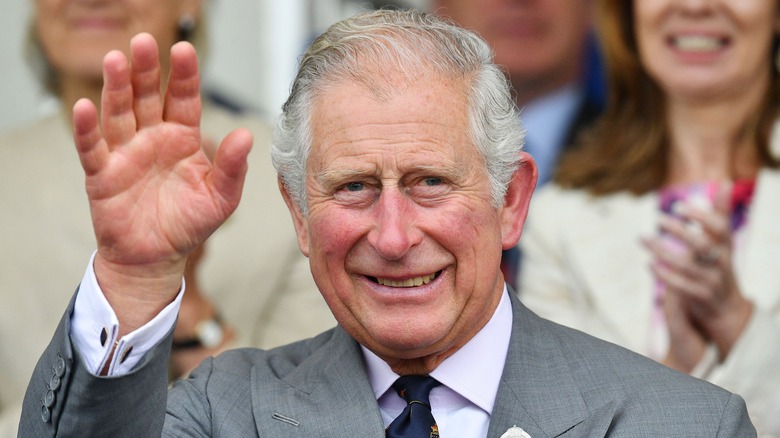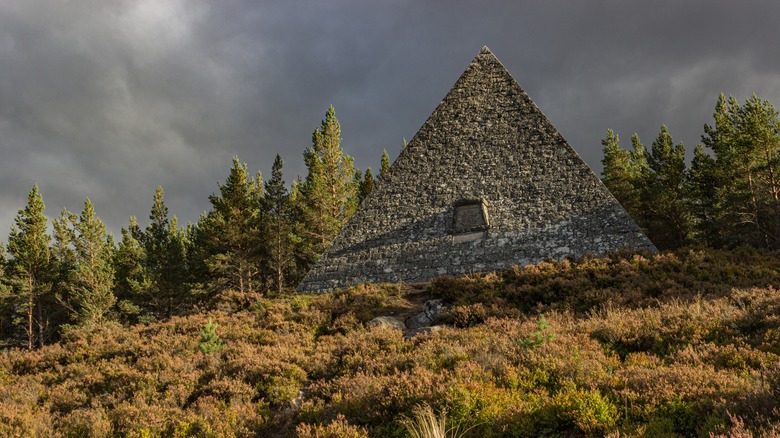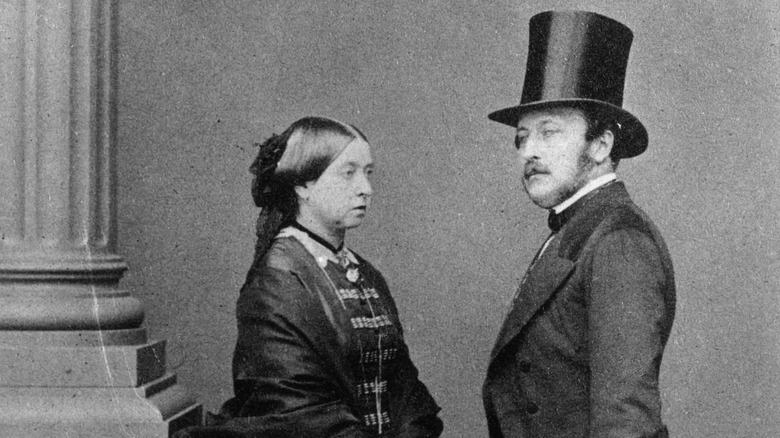King Charles' Balmoral Estate Has A Hidden Memorial
Upon Queen Elizabeth II's passing, her son, King Charles III, inherited Balmoral estate, the expansive Scottish property adored by the late monarch. The retreat is best known for its grand castle, built after the land entered into royal family ownership in 1852 when Prince Albert purchased it. However, the grounds harbor another impressive structure — a hidden memorial.
While it's obscured from the view of passersby, nestled in a plot of trees, the secret pyramid is anything but inconspicuous. The massive structure, standing 35 feet tall and measuring 41 feet on all sides of the base, resembles one of Egypt's iconic pyramids. However, the memorial isn't technically a pyramid. Rather, Prince Albert's Cairn is just one of 11 cairns dotting the property.
Built from granite, Queen Victoria didn't intend for it to be hidden. She selected its dimensions to purposely stand out against the Scottish Highlands, writing in her journal, "It could be seen all down the valley," (via the Royal Collection Trust). That's because the structure was an ode to her late husband, who gifted Victoria with the sprawling estate nearly 10 years before his death.
Queen Victoria was a widow in mourning
Queen Victoria and Prince Albert were said to have fallen in love at first sight. In a sort of royal meet-cute, the pair first crossed paths at the queen's 17th birthday party. But by the time their relationship turned serious and Albert was ready to propose, Victoria was already queen, and according to royal decree, a reigning monarch cannot receive a proposition of marriage. Instead of the typical royal proposal, she got down on one knee (though probably not literally) for her beloved.
The couple was married for over two decades and had nine children together; the relationship only ended when Albert passed in 1861. Victoria was so heartbroken over her husband's death that in 1862, she erected his cairn, a Gaelic term that means a heap of stones stacked by man. On it, the suffering wife wrote, "To the Beloved Memory of Prince Albert, the Great and Good Prince Consort, Erected by his Broken-hearted Widow, VICTORIA R," per the Royal Collection Trust. Directly beneath her description, Victoria included two verses from the book, "The Wisdom of Solomon."
Visitors can walk the grounds when members of the royal family aren't vacationing at Balmoral Castle and even make their way to the hidden pyramid within the 50,000 acres. Prince Albert's Cairn is far from the only structure on the property, which houses 150 buildings in total, some of which are cottages that can be rented by the public.
The memorial wasn't the only way she honored her husband
Prince Albert passed away at the relatively young age of 42 after contracting typhoid fever, which understandably came as a massive shock to the queen. She and her husband had a very close relationship, and it was no secret that Albert cherished his wife and children. Similarly, Queen Victoria kept very detailed diaries that conveyed her feelings for the Prince Consort, some of which were quite risqué.
Touted as a true love match, when death separated the two, Her Majesty was distraught. She dressed in black for the remainder of her life in mourning for her husband, eventually garnering the moniker the "Widow of Windsor." In addition to his cairn and her attire, she protected her husband's private rooms and everything in them, maintaining the spaces just as they were before his passing. Victoria also required a private mausoleum to be constructed at Frogmore House for Albert's final resting place, an unusual practice for royals often buried at Westminster Abbey or St George's Chapel in Windsor.
After it was completed, she made trips to the mausoleum quite frequently. Eventually, the queen joined her husband there upon her death. Rather than completely forsaking tradition, Victoria renovated Wolsey Chapel into a memorial for her husband – Albert Memorial Chapel. Today, the pyramid at Balmoral, in stark contrast to the surrounding landscape, reflects the couple's unique love story, which stood out among the typically practical and dutiful marriages of the time.


